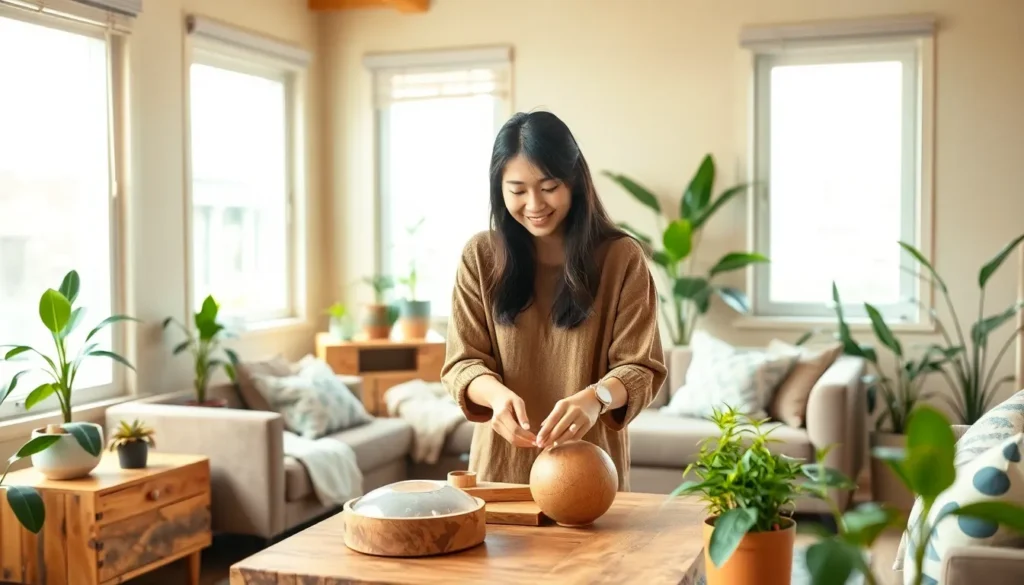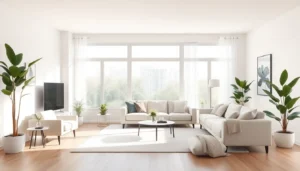In a world where fast fashion and throwaway culture reign supreme, sustainable decor is the stylish rebel everyone’s talking about. Imagine transforming your space into a sanctuary that not only looks good but also does good. It’s like giving Mother Nature a high-five while sipping organic herbal tea—totally chic and guilt-free!
Table of Contents
ToggleWhat Is Sustainable Decor?
Sustainable decor focuses on creating living spaces that combine style with environmental responsibility. This concept emphasizes using materials and products sourced from renewable resources. It prioritizes functionality and durability, ensuring that items last longer, reducing waste over time.
Reclaimed wood, bamboo furniture, and recycled textiles serve as popular choices within sustainable decor. Each material not only looks good but also carries a lower environmental footprint. Designers increasingly opt for low-VOC paints and finishes, which enhance indoor air quality while remaining visually appealing.
Sustainable decor also involves choosing local artisans and manufacturers. Purchasing locally reduces transportation emissions and supports community economies. Consumers often select handmade items that tell a story, enhancing the unique character of their spaces.
Incorporating plants into decor not only beautifies a home but also improves air quality. Many prefer native species that require less water and maintenance. Natural lighting plays a crucial role too; positioning windows to maximize daylight can reduce energy consumption significantly.
Sustainable practices extend beyond materials and aesthetics. Mindful consumption encourages individuals to invest in fewer, high-quality pieces. By focusing on minimalism, they create inviting spaces without clutter.
Adopting sustainable decor reflects a commitment to environmental stewardship and personal well-being. It’s about making choices that result in a more harmonious relationship with nature and the planet.
The Importance of Sustainable Decor

Sustainable decor plays a crucial role in promoting a healthier environment and encouraging community welfare. Committing to sustainable practices leads to meaningful changes both locally and globally.
Environmental Impact
Sustainable decor significantly reduces waste and conserves natural resources. Using materials like reclaimed wood and bamboo minimizes the demand for new resources, aiding in ecosystem preservation. Furniture and decor crafted from recycled materials help divert waste from landfills. Low-VOC paints improve indoor air quality, directly benefiting residents. Incorporating plants into home decor enhances air purification while contributing to energy reduction through natural insulation. Overall, thoughtful choices in decor lead to a smaller carbon footprint and support environmental health.
Social Responsibility
Selecting sustainable decor creates positive social impacts within communities. Supporting local artisans fosters economic growth while reducing transportation emissions. When individuals invest in handmade or locally sourced items, they encourage fair labor practices and community craftsmanship. Purchasing sustainable goods often means investing in quality over quantity, promoting a lifestyle of minimalism and mindful consumption. This collective shift towards sustainable living nurtures a sense of responsibility for the planet and strengthens community bonds. Active engagement in sustainable decor choices cultivates greater awareness of social and environmental issues.
Key Elements of Sustainable Decor
Sustainable decor incorporates various components that prioritize environmental responsibility and style. Emphasizing natural materials and thoughtful design elevates both aesthetic and ecological value.
Materials and Sourcing
Materials play a critical role in sustainable decor. Reclaimed wood offers versatility and character, making it popular for furniture and accents. Bamboo furniture stands out for its rapid growth and renewability, providing durable and attractive options. Recycled textiles contribute to a reduction in waste while enhancing fabric quality. Utilizing low-VOC paints improves indoor air quality and minimizes harmful emissions. Supporting local artisans reduces transportation emissions and fosters community economies, creating a direct link between decor choices and environmental impact.
Design Principles
Design principles in sustainable decor focus on functionality and minimalism. Prioritizing natural light creates inviting spaces while reducing energy consumption. Incorporating plants not only beautifies a setting but also enhances air purification. Choosing fewer, high-quality pieces eliminates clutter and fosters mindfulness in consumption. Flexibility in design allows for adaptability over time, reducing the likelihood of replacement. Such principles nurture a balanced relationship with the environment, showcasing that beauty and sustainability can coexist harmoniously.
Tips for Implementing Sustainable Decor
Sustainable decor transforms spaces while promoting environmental responsibility. Engaging in eco-conscious choices leads to stylish, inviting areas.
DIY Projects
Crafting unique items from reclaimed materials fosters creativity and sustainability. Building furniture from pallets or transforming jars into decorative planters showcases individual style while minimizing waste. Upcycling old textiles into throw pillows or decorative wall hangings creates personalized decor that reduces material consumption. Investing time in DIY projects nurtures craftsmanship and encourages mindful consumption, making home environments both beautiful and eco-friendly.
Choosing Eco-Friendly Products
Opting for eco-friendly products enhances sustainability in home decor. Selecting furniture made from bamboo or recycled materials promotes renewable resources and durability. Low-VOC paints ensure better indoor air quality while emphasizing aesthetic appeal. Supporting local artisans guarantees fair labor practices and reduces transportation emissions, building community connections. Focusing on natural fibers in textiles helps maintain ecological balance while adding warmth to living spaces. Prioritizing sustainability during purchasing decisions contributes to a healthier planet and enriched living experience.
Sustainable decor represents a transformative approach to creating beautiful living spaces that prioritize environmental health and community well-being. By choosing materials like reclaimed wood and bamboo, individuals not only enhance their homes but also contribute to a more sustainable future.
Embracing mindful consumption encourages a shift away from disposable culture towards lasting quality. This commitment to eco-friendly design fosters a deeper connection with nature while supporting local artisans and economies.
Ultimately, sustainable decor isn’t just about aesthetics; it’s about cultivating a lifestyle that respects the planet and nurtures meaningful relationships within the community. As more people adopt these principles, the collective impact can lead to significant positive change for both individuals and the environment.





